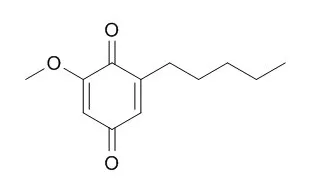| Description: |
Primin has antimycobacterial, and strong antineoplastic actions. Primin has potent activity against Trypanosoma brucei rhodesiense (IC50 0.144 microM) and Leishmania donovani (IC50 0.711 microM), and low cytotoxicity (IC50 15.4 microM) on mammalian cells; it could serve as a lead compound for the rational design of more potent and less toxic antiprotozoal agents. |
| Targets: |
Antifection |
| In vitro: |
| Chem Biodivers. 2006 Nov;3(11):1230-7. | | Antituberculotic and antiprotozoal activities of primin, a natural benzoquinone: in vitro and in vivo studies.[Pubmed: 17193236] | Primin (=2-methoxy-6-pentylcyclohexa-2,5-diene-1,4-dione), a natural benzoquinone synthesized in our laboratory, was investigated for its in vitro antiprotozoal, antimycobacterial, and cytotoxic potential.
METHODS AND RESULTS:
Primin showed very potent activity against Trypanosoma brucei rhodesiense (IC50 0.144 microM) and Leishmania donovani (IC50 0.711 microM), and revealed low cytotoxicity (IC50 15.4 microM) on mammalian cells. Only moderate inhibitory activity was observed against Mycobacterium tuberculosis, Trypanosoma cruzi, and Plasmodium falciparum. When tested for in vivo efficacy in a Trypanosoma b. brucei rodent model, Primin failed to cure the infection at 20 mg/kg given intraperitoneally. Primin was too toxic in vivo at a higher concentration (30 mg/kg, injected i.p. route) in mice infected with L. donovani.
CONCLUSIONS:
Taken together, Primin can serve as a lead compound for the rational design of more potent and less toxic antiprotozoal agents. |
|
| In vivo: |
| Rev Inst Antibiot (Recife). 1974 Dec;14(1-2):9-16. | | First observations on the topical use of Primin, Plumbagin and Maytenin in patients with skin cancer.[Pubmed: 4620478] | Eleven cases of patients bearing basic cellular carcinoma, and one case of patient bearing Kaposi's sarcomatosis, all treated with antibiotics isolated by Goncalves de Lima and Co-workers at the Instituto de Antibióticos, are presented by the authors.
METHODS AND RESULTS:
Primin, an antibiotic extracted from a vegetal named Miconia sp. (Herb. I.A.-1903) with a 2-metoxi-6-n-pentil-p benzoquinone structure, presented a strong antineoplastic action in the cases treated. Plumbagin isolated from Plumbago scandens in local use, was responsible for a complete healing of the injuries treated. Maytenin extracted from Maytenus sp. (Herb. I.A.-1750) showed less activity than the two previous mentioned, but with a low irritant action and late antineoplastic properties. The authors are going on these experiments.
CONCLUSIONS:
They believe that these antibodies, in local use, may advantageously substitute the surgery and the radiotherapy, meanly in those external ear tumidities and back of the nose, owing to a hurtful action in cartilage, provoked by radiotherapy. |
|






 Cell. 2018 Jan 11;172(1-2):249-261.e12. doi: 10.1016/j.cell.2017.12.019.IF=36.216(2019)
Cell. 2018 Jan 11;172(1-2):249-261.e12. doi: 10.1016/j.cell.2017.12.019.IF=36.216(2019) Cell Metab. 2020 Mar 3;31(3):534-548.e5. doi: 10.1016/j.cmet.2020.01.002.IF=22.415(2019)
Cell Metab. 2020 Mar 3;31(3):534-548.e5. doi: 10.1016/j.cmet.2020.01.002.IF=22.415(2019) Mol Cell. 2017 Nov 16;68(4):673-685.e6. doi: 10.1016/j.molcel.2017.10.022.IF=14.548(2019)
Mol Cell. 2017 Nov 16;68(4):673-685.e6. doi: 10.1016/j.molcel.2017.10.022.IF=14.548(2019)